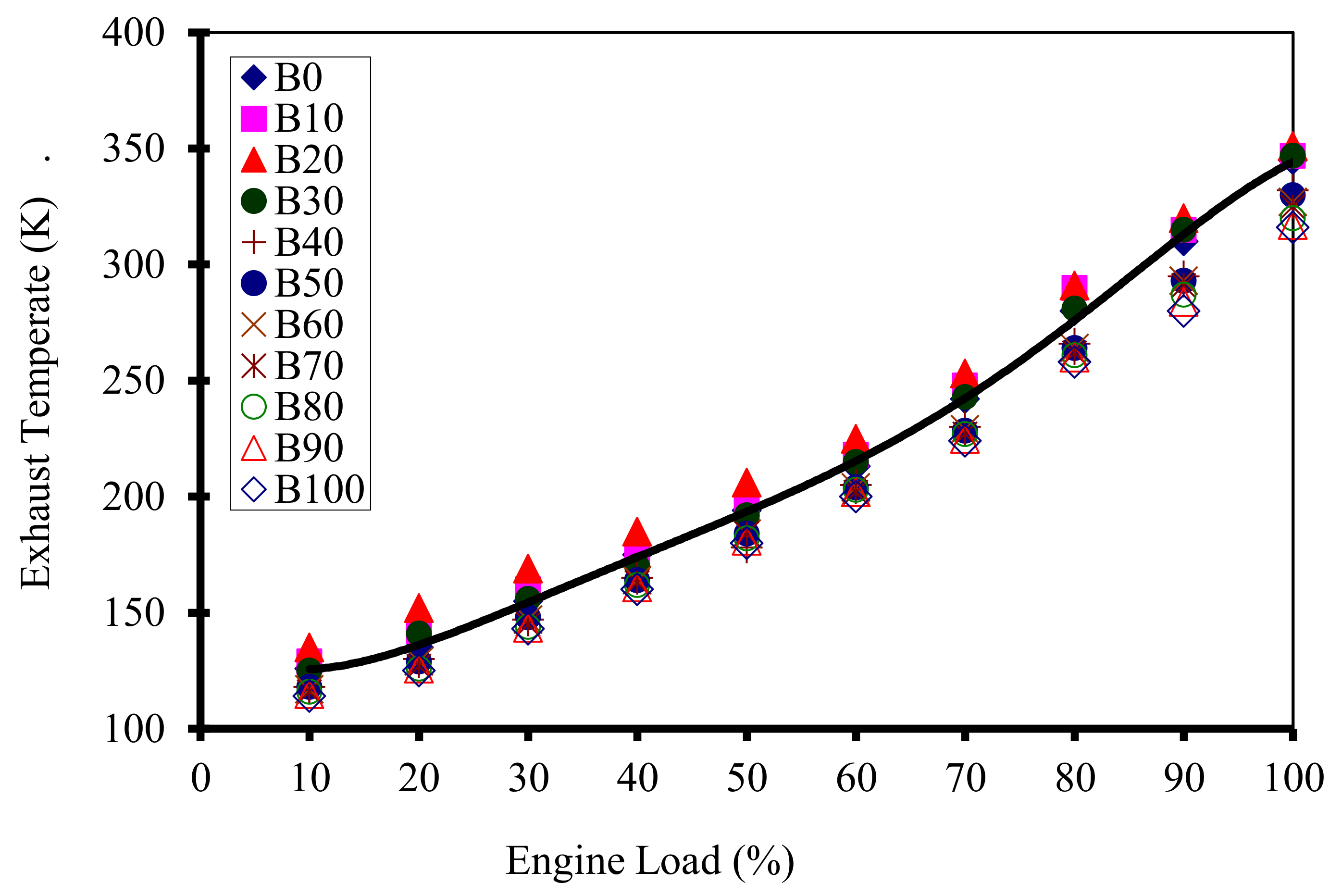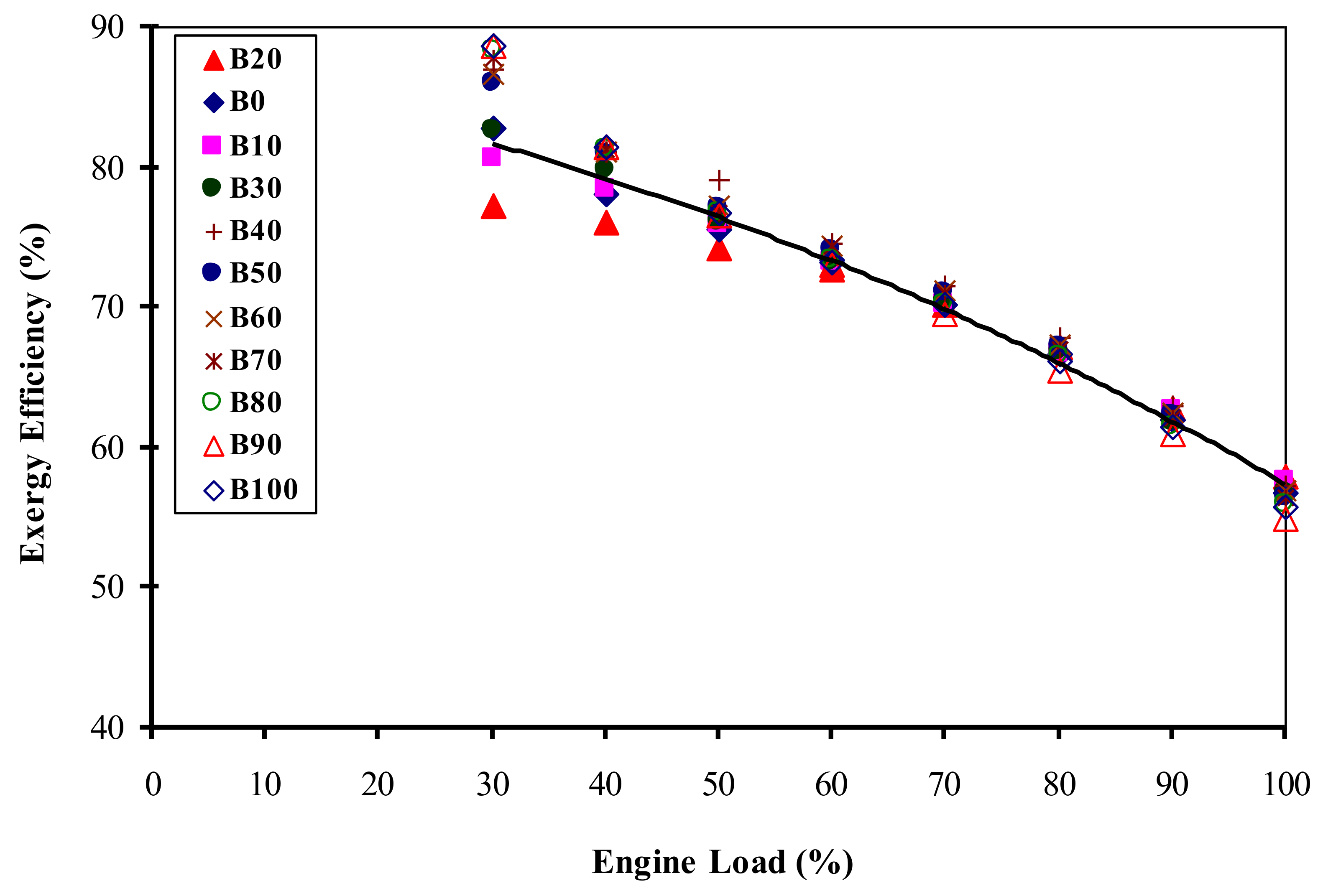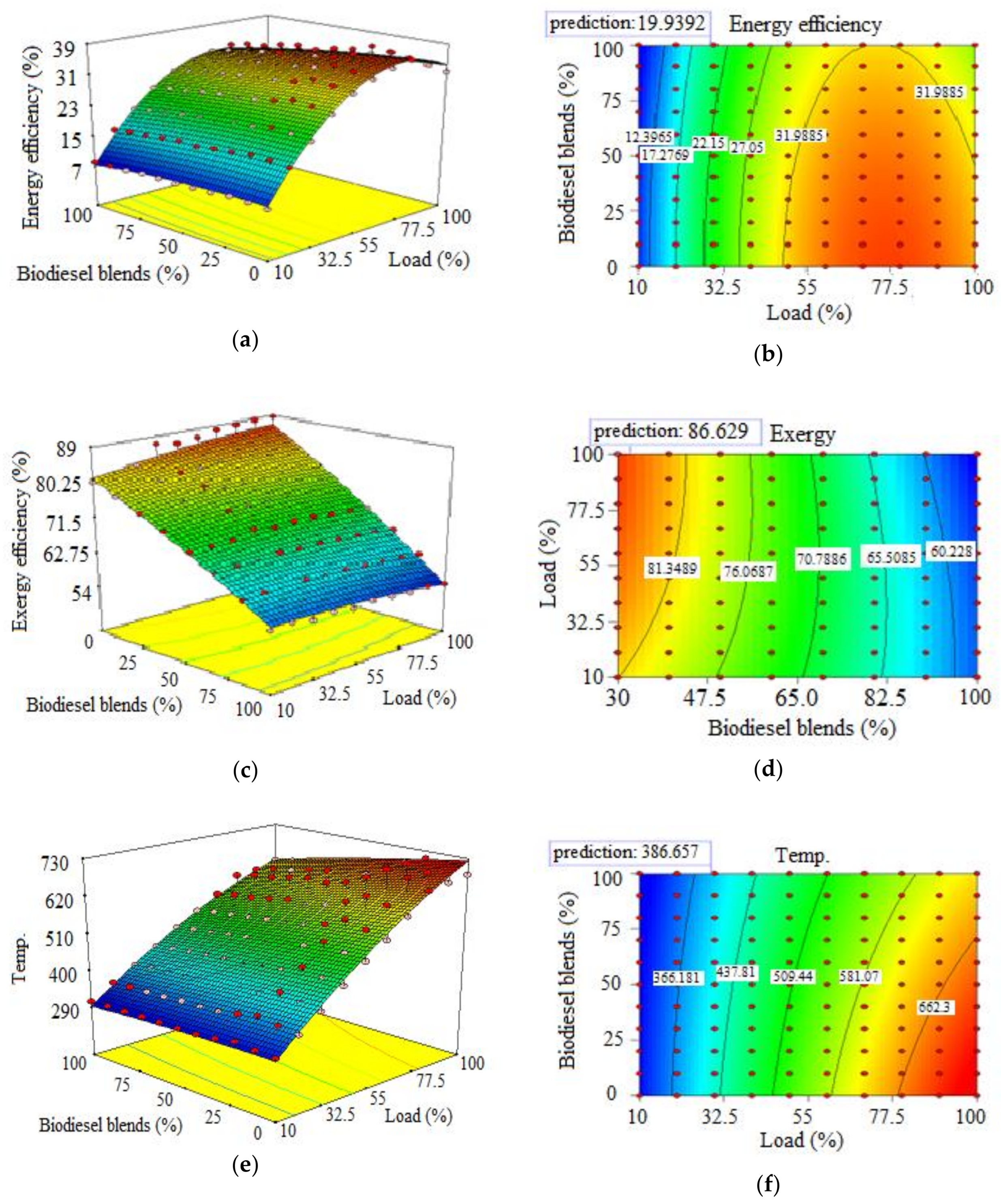An Intelligent Artificial Neural Network-Response Surface Methodology Method for Accessing the Optimum Biodiesel and Diesel Fuel Blending Conditions in a Diesel Engine from the Viewpoint of Exergy and Energy Analysis
Abstract
:1. Introduction
2. Experimental Setup and Test Procedure
2.1. Fuel Properties
2.2. Experimental Test Matrix
2.3. Experimental Equipment
2.4. Engine Test Method
3. Modeling the Thermal Engine
3.1. Mathematical Modeling
3.2. Intelligent Modeling
3.3. ANN Network Training
3.4. Evaluation of the Developed Models
4. Results and Discussion
4.1. BSFC
4.2. Exhaust Gas Temperature
4.3. Energy Efficiency
4.4. Exergy and Energy Efficiency
4.5. ANN Modeling
4.6. ANN-RSM Method
5. Conclusions
Author Contributions
Conflicts of Interest
Abbreviations
| List of Symbols | |
| ASTM | American Society for Testing and Materials |
| ELM | Extreme learning machine |
| MS | Mass |
| WCO | Waste cooking oil |
| ANN | Artificial neural network |
| RSM | Response surface methodology |
| SVM | Support vector machine |
| HCCI | Homogeneous charge compression ignition |
| DI | Direct Injection |
| DoE | Design of experiments |
| EGR | Exhaust Gas Recirculation |
| F | Engine Load, N |
| Brake Power, kW | |
| NRPM | Engine Speed (rpm) |
| Mass Flow Rate (kg/s) | |
| ρ | Density (gr/cm3) |
| ts | Fuel Consumption Time (s) |
| Temperature of Combustion Chamber | |
| Temperature of Environment | |
| Lower Heating Value (MJ/kg) | |
| Thermal Power (kW) | |
| BM | Bi-harmonic maps |
| Losses Power (kW) | |
| MLP | Multi layered perceptron |
| WT | Wavelet transform |
| ANFIS | Adaptive neuro fuzzy inference system |
| MSE | Mean square error |
| ANFIS | Adaptive neuro fuzzy inference system |
| MAE | Mean absolute error |
| r | Correlation coefficient |
| RMSE | Root mean square error |
| BSFC | Brake specific fuel consumption |
| R2 | coefficient of variations |
| GC | Gas Chromatography |
| Energy Efficiency (%) | |
| Exergy Rate (kW) | |
| Exergy Destruction (kW) | |
| Entropy rate (kW/K) | |
| Chemicals Availability | |
| x, y, z | Number of Carbon, Hydrogen and Oxygen in the fuel |
| γ | Ratio of Specific Heat Capacity |
| CP | Specific Heat Capacity at constant pressure |
| CV | Specific Heat Capacity at constant volume |
| rc | Ratio of Engine compression |
| TEx | Exhaust temperature |
| β | Ratio of cutoff ratio |
References
- Khalife, E.; Kazeroni, H.; Mirsalim, M.; Shojaei, T.R.; Mohammadi, P.; Salleh, A.M.; Najafi, B.; Tabatabaei, M. Experimental investigation of low-level water in waste-oil produced biodiesel-diesel fuel blend. Energy 2017, 121, 331–340. [Google Scholar] [CrossRef]
- Najafi, B.; Pirouzpanah, V.; Najafi, G.; Yusaf, T.; Ghobadian, B. Experimental Investigation of Performance and Emission Parameters of a Small Diesel Engine Using CNG and Biodiesel; SAE Technical Paper; SAE International: Warrendale, PA, USA, 2007. [Google Scholar]
- Ali, O.M.; Mamat, R.; Abdullah, N.R.; Abdullah, A.A. Analysis of blended fuel properties and engine performance with palm biodiesel–diesel blended fuel. Renew. Energy 2016, 86, 59–67. [Google Scholar] [CrossRef]
- Attia, A.M.; Hassaneen, A.E. Influence of diesel fuel blended with biodiesel produced from waste cooking oil on diesel engine performance. Fuel 2016, 167, 316–328. [Google Scholar] [CrossRef]
- Zhang, Z.-H.; Balasubramanian, R. Investigation of particulate emission characteristics of a diesel engine fueled with higher alcohols/biodiesel blends. Appl. Energy 2016, 163, 71–80. [Google Scholar] [CrossRef]
- Woo, C.; Kook, S.; Hawkes, E.R.; Rogers, P.L.; Marquis, C. Dependency of engine combustion on blending ratio variations of lipase-catalysed coconut oil biodiesel and petroleum diesel. Fuel 2016, 169, 146–157. [Google Scholar] [CrossRef]
- Lei, T.; Wang, Z.; Chang, X.; Lin, L.; Yan, X.; Sun, Y.; Shi, X.; He, X.; Zhu, J. Performance and emission characteristics of a diesel engine running on optimized ethyl levulinate–biodiesel–diesel blends. Energy 2016, 95, 29–40. [Google Scholar] [CrossRef]
- Žaglinskis, J.; Lukács, K.; Bereczky, Á. Comparison of properties of a compression ignition engine operating on diesel–biodiesel blend with methanol additive. Fuel 2016, 170, 245–253. [Google Scholar] [CrossRef]
- Najafi, B.; Faizollahzadeh Ardabili, S. Effect of fatty acid ethyl esters in biodiesel on thermo-physical properties. Fuel Combust. 2016, 9, 121–133. [Google Scholar]
- Lapuerta, M.; Armas, O.; Rodriguez-Fernandez, J. Effect of biodiesel fuels on diesel engine emissions. Prog. Energy Combust. Sci. 2008, 34, 198–223. [Google Scholar] [CrossRef]
- Azoumah, Y.; Blin, J.; Daho, T. Exergy efficiency applied for the performance optimization of a direct injection compression ignition (CI) engine using biofuels. Renew. Energy 2009, 34, 1494–1500. [Google Scholar] [CrossRef]
- Moran, M.J.; Drake, M.S.; Shapiro, H.N. Fundamentals of Engineering Thermodynamics, Student Problem Set Supplement; John Wiley & Sons Inc.: Hoboken, NJ, USA, 2000. [Google Scholar]
- Sogut, M.Z. Exergetic irreversibility and sustainability performances for alternative fuels in the micro-turbojet engine. Int. J. Green Energy 2017, 15, 169–180. [Google Scholar] [CrossRef]
- Panigrahi, N.; Mohanty, M.K.; Mishra, S.R.; Mohanty, R.C. Energy and exergy analysis of a diesel engine fuelled with diesel and simarouba biodiesel blends. J. Inst. Eng. Ser. C 2018, 99, 9–17. [Google Scholar] [CrossRef]
- Aghbashlo, M.; Tabatabaei, M.; Khalife, E.; Najafi, B.; Mirsalim, S.M.; Gharehghani, A.; Mohammadi, P.; Dadak, A.; Shojaei, T.R. A novel emulsion fuel containing aqueous nano cerium oxide additive in diesel–biodiesel blends to improve diesel engines performance and reduce exhaust emissions: Part II—Exergetic analysis. Fuel 2017, 205, 262–271. [Google Scholar] [CrossRef]
- Jafarmadar, S.; Nemati, P. Multidimensional modeling of the effect of exhaust gas recirculation on exergy terms in a homogenous charge compression ignition engine fueled by diesel/biodiesel. J. Clean. Prod. 2017, 161, 720–734. [Google Scholar] [CrossRef]
- Jafarmadar, S.; Nemati, P. Exergy analysis of diesel/biodiesel combustion in a homogenous charge compression ignition (HCCI) engine using three-dimensional model. Renew. Energy 2016, 99, 514–523. [Google Scholar] [CrossRef]
- Nemati, P.; Jafarmadar, S.; Taghavifar, H. Exergy analysis of biodiesel combustion in a direct injection compression ignition (CI) engine using quasi-dimensional multi-zone model. Energy 2016, 115, 528–538. [Google Scholar] [CrossRef]
- Khoobbakht, G.; Akram, A.; Karimi, M.; Najafi, G. Exergy and energy analysis of combustion of blended levels of biodiesel, ethanol and diesel fuel in a di diesel engine. Appl. Therm. Eng. 2016, 99, 720–729. [Google Scholar] [CrossRef]
- Coban, K.; Şöhret, Y.; Colpan, C.O.; Karakoç, T.H. Exergetic and exergoeconomic assessment of a small-scale turbojet fuelled with biodiesel. Energy 2017, 140, 1358–1367. [Google Scholar] [CrossRef]
- Aghbashlo, M.; Tabatabaei, M.; Mohammadi, P.; Mirzajanzadeh, M.; Ardjmand, M.; Rashidi, A. Effect of an emission-reducing soluble hybrid nanocatalyst in diesel/biodiesel blends on exergetic performance of a di diesel engine. Renew. Energy 2016, 93, 353–368. [Google Scholar] [CrossRef]
- Shamshirband, S.; Tabatabaei, M.; Aghbashlo, M.; Yee, L.; Petković, D. Support vector machine-based exergetic modelling of a di diesel engine running on biodiesel–diesel blends containing expanded polystyrene. Appl. Therm. Eng. 2016, 94, 727–747. [Google Scholar] [CrossRef]
- Aghbashlo, M.; Shamshirband, S.; Tabatabaei, M.; Yee, L.; Larimi, Y.N. The use of ELM-WT (extreme learning machine with wavelet transform algorithm) to predict exergetic performance of a di diesel engine running on diesel/biodiesel blends containing polymer waste. Energy 2016, 94, 443–456. [Google Scholar] [CrossRef]
- Jafarmadar, S.; Nemati, P. Analysis of exhaust gas recirculation (EGR) effects on exergy terms in an engine operating with diesel oil and hydrogen. Energy 2017, 126, 746–755. [Google Scholar] [CrossRef]
- Aghbashlo, M.; Tabatabaei, M.; Mohammadi, P.; Khoshnevisan, B.; Rajaeifar, M.A.; Pakzad, M. Neat diesel beats waste-oriented biodiesel from the exergoeconomic and exergoenvironmental point of views. Energy Convers. Manag. 2017, 148, 1–15. [Google Scholar] [CrossRef]
- Mata, C.; de Oliveira Leite, W.; Moreno, R.; Agudelo, J.R.; Armas, O. Prediction of NOX emissions and fuel consumption of a city bus under real operating conditions by means of biharmonic maps. J. Energy Eng. 2016, 142, 04016018. [Google Scholar] [CrossRef]
- Sayin Kul, B.; Kahraman, A. Energy and exergy analyses of a diesel engine fuelled with biodiesel-diesel blends containing 5% bioethanol. Entropy 2016, 18, 387. [Google Scholar] [CrossRef]
- Sekmen, P.; Yılbaşı, Z. Application of energy and exergy analyses to a CI engine using biodiesel fuel. Math. Computational Appl. 2011, 16, 797–808. [Google Scholar] [CrossRef]
- Hoseinpour, M.; Sadrnia, H.; Tabasizadeh, M.; Ghobadian, B. Energy and exergy analyses of a diesel engine fueled with diesel, biodiesel-diesel blend and gasoline fumigation. Energy 2017, 141, 2408–2420. [Google Scholar] [CrossRef]
- Faizollahzadeh Ardabili, S.; Najafi, B.; Ghaebi, H.; Shamshirband, S.; Mostafaeipour, A. A novel enhanced exergy method in analyzing HVAC system using soft computing approaches: A case study on mushroom growing hall. J. Build. Eng. 2017, 13, 309–318. [Google Scholar] [CrossRef]
- Mostafaei, M.; Javadikia, H.; Naderloo, L. Modeling the effects of ultrasound power and reactor dimension on the biodiesel production yield: Comparison of prediction abilities between response surface methodology (RSM) and adaptive neuro-fuzzy inference system (ANFIS). Energy 2016, 115, 626–636. [Google Scholar] [CrossRef]
- Faizollahzadeh Ardabili, S. Simulation and comparison of control system in mushroom growing rooms environment. Master’s Thesis, Department of Mechanic of Agricultural Machinery Engineering, University of Tabriz, Tabriz, Iran, 2014. [Google Scholar]
- Cartwright, N. How the Laws of Physics Lie; Oxford Google Scholar; Oxford University Press: Oxford, UK, 1983. [Google Scholar]
- Hacking, I. Representing and Intervening: Introductory Topics in the Philosophy of Natural Science; Cambridge University Press: Cambridge, UK, 1983. [Google Scholar]
- Szargut, J. International progress in second law analysis. Energy 1980, 5, 709–718. [Google Scholar] [CrossRef]
- Rodríguez, L. Calculation of Available-Energy Quantities; ACS Publications: Washington, DC, USA, 1980. [Google Scholar]
- Ardabili, S.F.; Mahmoudi, A.; Gundoshmian, T.M. Modeling and simulation controlling system of HVAC using fuzzy and predictive (radial basis function, RBF) controllers. J. Build. Eng. 2016, 6, 301–308. [Google Scholar] [CrossRef]
- Yilmaz, I.; Kaynar, O. Multiple regression, ANN (RBF, MLP) and ANFIS models for prediction of swell potential of clayey soils. Expert Syst. Appl. 2011, 38, 5958–5966. [Google Scholar] [CrossRef]
- Gautam, R.; Panigrahi, S.; Franzen, D. Neural network optimisation of remotely sensed maize leaf nitrogen with a genetic algorithm and linear programming using five performance parameters. Biosyst. Eng. 2006, 95, 359–370. [Google Scholar] [CrossRef]
- Fathi, V.; Montazer, G.A. An improvement in RBF learning algorithm based on PSO for real time applications. Neurocomputing 2013, 111, 169–176. [Google Scholar] [CrossRef]
- Gundoshmian, T.M.; Ghassemzadeh, H.R.; Abdollahpour, S.; Navid, H. Application of artificial neural network in prediction of the combine harvester performance. J. Food Agric. Environ. 2010, 8, 721–724. [Google Scholar]
- Yilmaz, I.; Yuksek, G. Prediction of the strength and elasticity modulus of gypsum using multiple regression, ANN, and ANFIS models. Int. J. Rock Mech. Min. Sci. 2009, 46, 803–810. [Google Scholar] [CrossRef]
- Song, H.; Quinton, K.S.; Peng, Z.; Zhao, H.; Ladommatos, N. Effects of oxygen content of fuels on combustion and emissions of diesel engines. Energies 2016, 9, 28. [Google Scholar] [CrossRef]









| Fuel Properties | |||||
|---|---|---|---|---|---|
| Low Heating Value (MJ/kg) | Density at 15 °C (g/cm3) | Viscosity (CSt) | Cloud Point (°C) | Poor Point (°C) | Fuel Type |
| 42.57 | 0.823 | 2.45 | −4 | −24 | Diesel |
| 42.21 | 0.831 | 2.78 | −2 | −19 | B10 |
| 41.78 | 0.839 | 3.21 | 1.5 | −14 | B20 |
| 41.34 | 0.844 | 3.56 | 4 | −12 | B30 |
| 40.89 | 0.848 | 4.21 | 5 | −11 | B40 |
| 40.53 | 0.857 | 4.72 | 6 | −9 | B50 |
| 40.11 | 0.865 | 5.11 | 6 | −8 | B60 |
| 39.60 | 0.868 | 5.83 | 7 | −6 | B70 |
| 39.22 | 0.876 | 6.61 | 8.5 | −5 | B80 |
| 38.81 | 0.882 | 7.01 | 9 | −3 | B90 |
| 38.43 | 0.885 | 7.89 | 9 | −4 | B100 |
| Engine Type | Single cylinder, air cooled vertical, totally enclosed compression ignition, four stroke cycle |
| Combustion | Direct injection combustion system |
| No. of Cylinder | 1 |
| Bore × Stroke (mm) | 87.5 × 110 |
| Displacement Volume (cc) | 662 |
| Compression Ratio | 17:1 |
| Maximum Power | 5.52 kW |
| Engine Speed | Constant 1500 rpm |
| Number of Neurons | R2 | MSE | Number of Neurons | R2 | MSE | ||
|---|---|---|---|---|---|---|---|
| 12 | Energy Eff. | 0.9335 | 4.7825 | 16 | Energy Eff. | 0.977 | 1.2979 |
| Exergy Eff. | 0.9542 | 48.3648 | Exergy Eff. | 0.9885 | 3.9593 | ||
| Temp | 0.9923 | 112.4987 | Temp | 0.9996 | 2.41 | ||
| 10 | Energy Eff. | 0.9705 | 2.1193 | 18 | Energy Eff. | 0.9839 | 1.1877 |
| Exergy Eff. | 0.9825 | 18.5176 | Exergy Eff. | 0.9808 | 20.1397 | ||
| Temp | 0.9959 | 61.6531 | Temp | 0.9992 | 11.6233 | ||
| 14 | Energy Eff. | 0.9464 | 3.791 | ||||
| Exergy Eff. | 0.9792 | 22.7518 | |||||
| Temp | 0.9961 | 57.95 | |||||
| Parameter | RMSE | r | MAE |
|---|---|---|---|
| Energy Efficiency | 1.0288 | 0.9925 | 0.7861 |
| Exergy Efficiency | 4.3841 | 0.9907 | 2.5815 |
| Exhaust Temoerature | 2.8411 | 0.9997 | 2.1847 |
© 2018 by the authors. Licensee MDPI, Basel, Switzerland. This article is an open access article distributed under the terms and conditions of the Creative Commons Attribution (CC BY) license (http://creativecommons.org/licenses/by/4.0/).
Share and Cite
Najafi, B.; Faizollahzadeh Ardabili, S.; Mosavi, A.; Shamshirband, S.; Rabczuk, T. An Intelligent Artificial Neural Network-Response Surface Methodology Method for Accessing the Optimum Biodiesel and Diesel Fuel Blending Conditions in a Diesel Engine from the Viewpoint of Exergy and Energy Analysis. Energies 2018, 11, 860. https://doi.org/10.3390/en11040860
Najafi B, Faizollahzadeh Ardabili S, Mosavi A, Shamshirband S, Rabczuk T. An Intelligent Artificial Neural Network-Response Surface Methodology Method for Accessing the Optimum Biodiesel and Diesel Fuel Blending Conditions in a Diesel Engine from the Viewpoint of Exergy and Energy Analysis. Energies. 2018; 11(4):860. https://doi.org/10.3390/en11040860
Chicago/Turabian StyleNajafi, Bahman, Sina Faizollahzadeh Ardabili, Amir Mosavi, Shahaboddin Shamshirband, and Timon Rabczuk. 2018. "An Intelligent Artificial Neural Network-Response Surface Methodology Method for Accessing the Optimum Biodiesel and Diesel Fuel Blending Conditions in a Diesel Engine from the Viewpoint of Exergy and Energy Analysis" Energies 11, no. 4: 860. https://doi.org/10.3390/en11040860
APA StyleNajafi, B., Faizollahzadeh Ardabili, S., Mosavi, A., Shamshirband, S., & Rabczuk, T. (2018). An Intelligent Artificial Neural Network-Response Surface Methodology Method for Accessing the Optimum Biodiesel and Diesel Fuel Blending Conditions in a Diesel Engine from the Viewpoint of Exergy and Energy Analysis. Energies, 11(4), 860. https://doi.org/10.3390/en11040860







